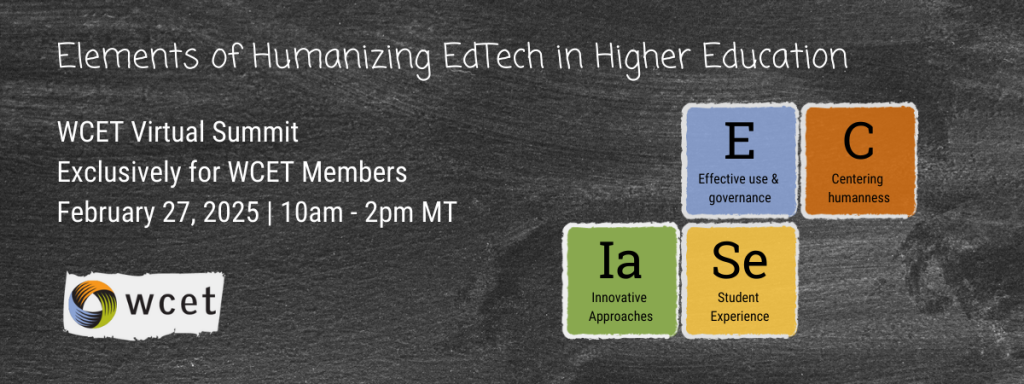Humanizing Ed-Tech Through the Human Advantage Framework™
Published by: WCET | 2/20/2025
Tags: Digital Learning, Distance Education, Managing Digital Learning, Online Learning, Student Success, Virtual Summit, WCET
Published by: WCET | 2/20/2025
Tags: Digital Learning, Distance Education, Managing Digital Learning, Online Learning, Student Success, Virtual Summit, WCET
Here at WCET, our focus is on educational technology and digital learning. While many of us enjoy learning about the latest and greatest tech tools, we know technology alone is not at the heart of our work. The most advanced digital learning tool holds little value if our students are unable to use it effectively or if our educators aren’t sure how to use it in a classroom setting. Instead, our work focuses on how technology can be used to enhance learning, more effectively engage with students, and inspire connection no matter where or how that education is being delivered. That’s why our entire team is really excited about the Keynote Speaker for our upcoming Virtual Summit – Elements of Humanizing EdTech in Higher Education, which takes place February 27, 2025 (that’s next week for those of us still taking down Christmas decorations!). Eric Rodriguez, speaker, futurist, and strategist, will open the Summit with his presentation on The Future of Human Experience and his framework that will help us all keep our focus on what really matters.
In this post, Eric introduces the Human Advantage Framework™, a people-first approach to integrating technology while keeping students, faculty, and learning experiences at the center. This framework offers a clear, repeatable process for ensuring that ed-tech decisions prioritize human connection and meaningful learning outcomes.
We’re finishing up our preparations for the Summit, but we’d love for you to join us! Learn more and register now!
Enjoy the read,
Lindsey Downs, WCET
As educational technology continues to evolve, the challenge is no longer about simply adopting new tools—it’s about ensuring that technology enhances, rather than replaces, human connection, learning, and engagement.
Higher education is at a crossroads. Institutions can either proactively its future or remain in a reactive cycle, trying to catch up with technological shifts. What if innovation wasn’t something we constantly chase, but something we lead to with intention and purpose?
This is the foundation of the Human Advantage Framework™—a people-first approach to humanizing innovation in higher education.
Rather than treating innovation as a one-time event or a response to external forces, this framework provides a simple, repeatable process for integrating technology while keeping students, faculty, and learning experiences at the center of decision-making.
The Human Advantage Framework™ is built on three core actions that ensure innovation is intentional, inclusive, and future-ready:
1. Be Curious – Explore Innovation with a People-First Mindset

Innovation begins with curiosity and a deep understanding of people. Before implementing new technology, institutions can explore how students learn, what challenges they face, and how technology can serve as a bridge to engagement rather than a barrier.
A university looking to implement AI-powered student support first engages students and faculty, identifying their unique needs before selecting a tool that aligns with their challenges and learning preferences.
2. Assess
– Evaluate How Technology Aligns with Learning & Equity

Once we have a clear understanding of people’s needs, the next step is to assess whether a new technology actually enhances education. The goal is to ensure that tools improve accessibility, engagement, and adaptability rather than just adding complexity.
Before introducing a chatbot for academic advising, an institution evaluates its impact on student engagement, ensuring that it reduces faculty workload while maintaining personalized student support.
3. OPTIMIZE – CREATE SUSTAINABLE, SCALABLE INNOVATION

True innovation isn’t just about implementation—it’s about continuous improvement and long-term impact.
Institutions that create a culture of innovation will ensure that their ed-tech strategies evolve alongside students’ needs and workforce demands.
A university launches an AI-powered learning platform, then continuously measures student engagement, refines content based on feedback, and ensures the tool remains relevant as learning needs evolve.
The theme of WCET’s Virtual Summit—Humanizing Ed-Tech in Higher Education—highlights the need to balance technological innovation with human connection.
This perspective is central to my keynote, “The Future of Human Experience,” in which I will explore how the Human Advantage Framework™ empowers institutions to make technology-enhanced learning truly human-centered.
By embracing curiosity, critical assessment, and continuous optimization, higher education leaders can ensure that their institutions are not just keeping up with innovation, but leading it in a way that enhances learning for all.
Because the future of education isn’t just about AI, it’s about the people it serves.

Speaker, Futurist & Strategist , Change Maker LLC